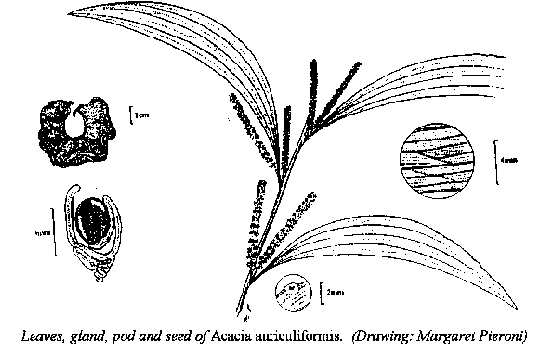Acacia auriculiformis – a multipurpose tropical wattle

FACT 96-05, September 1996
A quick guide to multipurpose trees from around the world
Acacia auriculiformis A. Cunn. ex Benth. is a multipurpose, leguminous tree in the subfamily Mimosoideae. It has been planted for fuelwood production, erosion control, ornament and shade in many tropical areas in the world. Its rapid early growth; ability to fix nitrogen; tolerance of infertile, acid, alkaline, saline or seasonally waterlogged soils; and tolerance of moderate dry seasons make it a very useful species for rehabilitation of degraded lands. The scientific name comes from the Latin ‘auricula’– external ear of animals and ‘forma’– form, figure or shape, in allusion to the shape of the pod.

Botany
It is commonly a tree, 8-20 m in height, heavily branched with a short bole. On favorable sites it can grow to 30-40 m tall and 80-100 cm diameter with a straight, single stem. The bark is gray or brown, more or less smooth in young trees, becoming rough and longitudinal fissured with age. Mature foliage consists of phyllodes, which may be straight or falcate, acute or sub-falcate, 10-20 cm long and 1.5-3.0 cm wide. Phyllodes of sapling may attain 30 cm in length and up to 5.0 cm in width. There are 3 prominent longitudinal nerves running together towards the lower margin or in the middle near the base, with many fine crowded secondary nerves, and a distinct gland at the base of the phyllode (Pedley 1978).
Inflorescences are in spikes up to 8 cm long in pairs (seldom three) in the upper axils. Each inflorescence is comprised of about 100 tiny (3.8 x 4.1 mm) bright yellow flowers (Ibrahim and Awang 1991). Flowers are 5-merous; the calyx 0.7-1.0 mm long, with short lobes; the corolla is 2- 2.5 times as long as the calyx. Stamens are approximately 3 mm long. The pods are slightly woody, glaucous and transversely veined, about 6.5 cm long and 1.5 cm wide. They are initially straight or curved but become very twisted and irregularly coil on maturity. The seeds are broadly ovate to elliptical, about 4-6 mm long and 3-4 mm wide. Each seed is encircled by a long red, yellow or orange funicle. There are 60,000 seeds per kg.
Ecology
Acacia auriculiformis occurs from near sea level to 400 m, but is most common at elevation less than 80 m. It is redominantly found in the seasonally dry tropical lowlands in the humid and subhumid zones. The mean annual rainfall in its natural range varies from 700-2000 mm, and the dry season (i.e. monthly rainfall less than 40 mm) may be 7 months. The mean maximum temperature of the hottest month is 32-34° C and the mean minimum of the coolest month is 17-22° C.
The species is commonly riparian, i.e. ringing perennial rivers and semi-perennial creeks, and tends to form discontinuous populations along drainage systems. It is found most commonly on clay soil types, however it exhibits theability to grow in a variety of soils including calcareous sands and black cracking clays. It can also tolerate highly alkaline and saline soils. Seedlings have the ability to compete with Imperata cylindrica during early growth phases and once mature may reduce the grass to a sparse ground cover.
Distribution
Acacia auriculiformis is endemic to Australia, Papua New Guinea and Indonesia, having a disjunct distribution in three main areas: the lowlands of southern half of the island of New Guinea (Papua New Guinea and Irian Jaya, Indonesia); the lowlands of tropical Northern Territory, Australia; and the Cape York Peninsula of northern Queensland, Australia. It has been widely introduced to many tropical countries in South and Southeast Asia, Africa and Latin America.
Uses
Wood. Heartwood varies from light brown to dark red. The wood makes attractive furniture and is suitable for construction work, turnery and carving. Plantation-grown trees have shown promise for the production of unbleached kraft pulp — for bags and wrapping paper; and high quality neutral sulphite semi-chemical pulp — for corrugating, medium and higher-grade packaging products (Logan 1987). The wood has a high basic density (500-650 kg/m³) and a calorific value of 4700-4900 kcal/kg, which make it ideal for firewood and charcoal.
Land Rehabilitation & Landscaping. The spreading, densely-matted root system stabilizes eroding land. Its rapid early growth, even on infertile sites, and tolerance of both highly acidic and alkaline soils make it popular for stabilizing and revegetating mine spoils. It is used for shade and ornamental purposes in cities where its hardiness, dense foliage and bright yellow flowers are positive attributes.
Other Uses. The bark has sufficient tannins for possible commercial exploitation (Abdul Razak et al. 1981). A natural dye, used in the batik textile industry in Indonesia, is also extracted from the bark. Its flowers are a source of bee forage for honey production (Moncur et al.1991).
Silviculture
Propagation. Propagation is generally by seed. Pregermination treatment is essential to promote seed germination. Immersion of seed in ample boiling water for 1-2 minutes is suitable to break dormancy. Germination is rapid after pretreatment and typically exceeds 70%. In general, 3-4 months are needed to raise seedlings to a plantable size, 25 cm in height. Inoculation with appropriate rhizobia may be beneficial, especially when seedlings are raised in sterilized soil.
Management. Establishment is successful by containerized seedlings or by direct seeding. Containerized seedling generally give higher survival, especially in areas of heavy weed competition. In the field, weed control is essential during the first 1-2 years. A small dose of NPK fertilizer in the first year helps improve initial growth – fertilization rates depend on site quality. Recommended spacing is 2×2 or 2×4 m. Acacia auriculiformis has the ability to coppice, but it is not a vigorous sprouter. It responds well to pollarding.
Yield. An increment in height of 2-4 m per year in the first few years is common even on soils of low fertility (Boland 1989). On relatively fertile Javanese soils receiving 2000 mm annual rainfall, a mean annual increment of 15-20 m³/ha is obtainable but on less fertile or highly eroded sites the increment is reduced to 8-12 m³/ha (Wiersum and Ramlan 1982). Recommended rotation is 4-5 years for fuelwood, 8-10 years for pulp and 12-15 years for timber. One or two thinnings are required with longer rotations, depending on initial spacing, site quality and tree growth.
Symbiosis
Acacia auriculiformis can fix nitrogen after nodulating with a range of Rhizobium and Bradyrhizobium strains. It also has associations with both ecto- and endo-mycorrhizal fungi.
Limitations
The propensity to produce multiple and crooked stems reduce its utility. It is susceptible to fire; even trees 10-15 years old can be killed. Stressed trees are found to be highly susceptible to attack by leaf insects.
Genetics & Provenances
Isozyme studies revealed marked genetic variation in A.auriculiformis. Three distinct groups of populations corresponding to the geographic distribution in Papua NewGuinea, Queensland and Northern Territory (Wickneswari and Norwati 1991). These regional groupings are also apparent in seedling morphology (Pinyopusarerk et al. 1991). Additionally, field trials have shown marked differences in growth and form. Provenances from Papua New Guinea have the highest production while those from Queensland have a high proportion of single stems. Those from the Northern Territory are inferior in both growth and form (Harwood et al. 1991).
Research Needs
Selection and breeding for superior growth and stem form are now underway in many countries, including Thailand and Vietnam. Natural hybrids of A. auriculiformis x A. mangium have shown desirable characteristics; e.g. vigor, fine branching and tendency for a strong apical dominance. These characteristics lead to healthy trees with single stems and a good clear bole. Production and vegetative propagation of these hybrids warrant detailed study.
References
Abdul Razak, M.A., Low, C.K. and Abu Said, A. 1981. Determination of relative tannin contents of the barks of some Malaysian plants. Malaysian Forester 44:87-92.
Boland, D.J. (ed.). 1989. Trees for the tropics: growing Australian multipurpose trees and shrubs in developing countries. ACIAR Monograph No. 10, 247 pp.
Harwood, C.E., Matheson, A.C. Gororo, N. and Haines, M.W 1991. Seed orchards of Acacia auriculiformis in Melville Island, Northern Territory, Australia. In: J.W. Turnbull (ed), Advances in tropical acacia research. ACIAR Proceedings No. 35. pp 87-91.
Ibrahim, Z. and Awang, K. 1991. Comparison of floral morphology, flower production and pollen yield of Acacia mangium and A. auriculiformis. In: Advances in tropical acacia research. pp 26-29. See Harwood et al. 1991.
Logan, A.F. 1987. Australian acacias for pulpwood. In: J.W. Turnbull (ed), Australian acacias in developing countries. ACIAR Proceedings No. 16. pp 89-94.
Moncur, M.W., Kleinschmidt, G. and Somerville, D. 1991. The role of acacia and eucalypt plantations for honey production. In: Advances in tropical acacia research. pp 123-27. See Harwood et al. 1991.
Pedley, L. 1978. A revision of Acacia Mill. in Queensland. Austrobaileya 1(2):75-234.
Pinyopusarerk, K. Williams, E.R., Boland, D.J. 1991. Geographic variation in seedling morphology of Acacia auriculiformis. Australian Journal of Botany 39:247-260.
Wickneswari, R. and Norwati, M. 1991. Genetic structure of natural populations of Acacia auriculiformis in Australia and Papua New Guinea. In: Advances in tropical acacia research. pp 94-95. See Harwood et al. 1991.
Wiersum, K.F. and Ramlan, A. 1982. Cultivation of Acacia auriculiformis in Java, Indonesia. Commonwealth Forestry Review 61:135-144.
Written by Khongsak Pinyopusarerk. Senior Experimental Scientist CSIRO Forestry & Forest Products, PO 4008, Canberra, ACT 2600, Australia.
